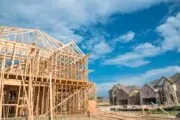
Following a record-setting year, British Columbia saw housing starts decline during the first month of 2022.
According to the British Columbia Real Estate Association (BCREA), province-wide housing starts fell to 39,400 units at a seasonally-adjusted annual rate (SAAR) in January, representing a month-over-month decrease of 29.2 per cent.
Overall, housing starts in the province were 33.7 per cent below the levels from January 2021. Meanwhile, the six-month moving average trend dropped 4.4 per cent to 42,300.
Tracking housing starts in areas of the province with 10,000 or more residents, the BCREA found that single-detached starts dropped 23.4 per cent month-over-month to 7,200 units, while multi-family starts decreased 33.4 per cent to 28,200 units.
“Increased housing supply is sorely needed all over the province, which is experiencing an historic drought in terms of the availability of homes,” said the BCREA in its 2022 housing forecast. “A record year of housing starts means a continued pipeline of residential investment that will keep employment in the construction sector robust.”
While housing demand remains high and the employment outlook is increasingly optimistic, labour shortages in B.C.’s construction industry threaten to slow the province’s pace, as pandemic-related job losses in other sectors haven’t funneled workers into construction roles.
A recent survey from the Independent Contractors and Businesses Association (ICBA) found that while 96 per cent of their member construction companies expect 2022 to be to be as busy or busier than 2021, 75 per cent can’t find enough workers to meet the demand.
A number of factors are related to the labour shortage, including skilled tradespeople reaching retirement age without enough young people or immigrants signing up to fill those vacancies.
“In Canada, we have an aging population and not enough people entering the workforce,” said ICBA president Chris Gardner. “The shortage of people combined with supply chain issues, means contractor margins are under enormous pressure. So while construction is busier, it’s much harder for contractors to maintain the same levels of profitability as in past years.”






